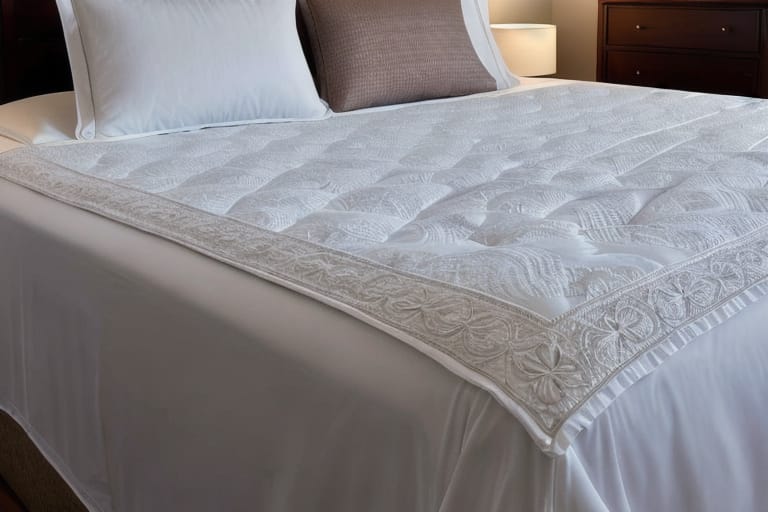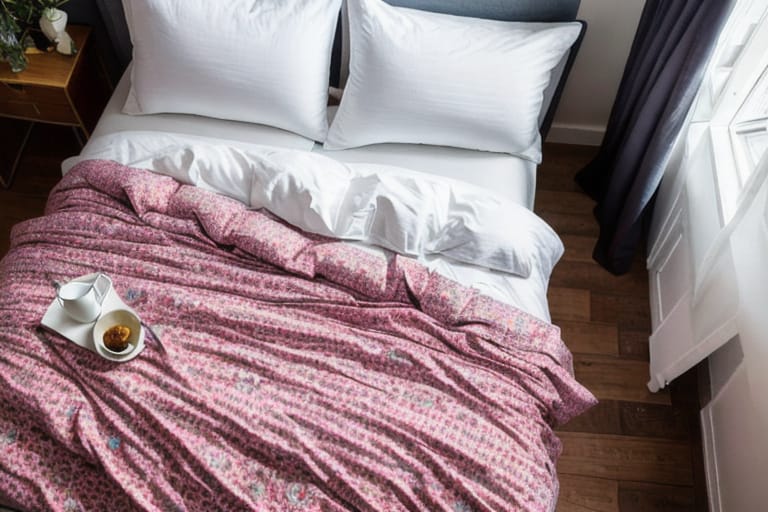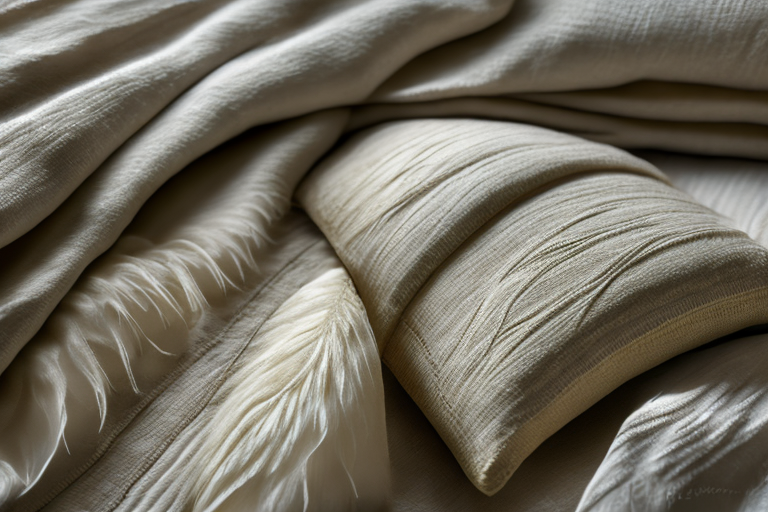Duck down quilts provide unparalleled comfort and insulation for the bedroom. But how do they compare to other down types in terms of quality, price, and longevity? This comprehensive guide examines down fill power, tog ratings, and other key factors to evaluate if duck down is worth the investment.
With information on sourcing, certifications, care, and hypoallergenic options, readers can make an informed decision if duck down bedding is right for their needs and budget. Let’s delve into the fluffiness!
What Defines Duck Down?
Duck down refers to the layer of fine, fluffy feathers located close to a duck’s skin that provides warmth and protection. This natural insulator has incredible loft that traps body heat.
Key properties:
- Extremely lightweight and breathable
- Delicate clusters with superb air-trapping abilities
- Biodegradable and compostable
- Sourced as a by-product of the food industry
Ethical standards enforced by certifications like the Responsible Down Standard ensure humane treatment during harvesting.
Why Choose Duck Down Bedding?

Duck down has distinct advantages over synthetic alternatives:
Natural Insulation
- Traps air efficiently to preserve warmth
- Maintains loft after compression
Comfort & Softness
- Light, airy feel akin to sleeping on a cloud
- Gentle cushioning that reduces pressure points
Temperature Regulation
- Breathability wicks moisture to keep sleepers cozy
- Dynamic fill adapts as you move around
Long-Lasting
- Highly durable with proper care
- Resilient when washed
For unrivaled softness and heat retention, duck down rises above.
How Does Duck Down Compare to Goose Down?
Duck and goose down share similarities, but also differ in key areas:
| Metric | Duck Down | Goose Down |
|---|---|---|
| Quill Diameter | Thinner | Thicker |
| Fill Power | Usually 550-650 | Typically 600-900 |
| Tog Rating | Comparable warmth | Comparable warmth |
| Durability | Similar when properly cared for | Similar when properly cared for |
| Odor | No natural scent | Can have a barnyard smell |
| Cost | $$ ($30-$200) | $$$ ($100+) |
The lower fill power of duck down brings a cost savings, but don’t sacrifice on warmth or quality. With proper construction methods by reputable manufacturers, duck down duvets provide comparable coziness to goose versions.
Evaluating Fill Power and Tog Ratings
Two key benchmarks indicate down performance:
What is Fill Power?
Fill power measures the loft and air trapping efficiency using cubic inches per ounce.
- Higher numbers like 700-900+ denote prime quality goose down
- Duck down typically ranges from 550 to 650 fill power
While lower fill may use more material to achieve equal warmth, advances in textile technology allows duck down to compete.
Understanding Tog Ratings
Tog ratings evaluate the overall thermal insulation of a duvet. It gauges how well the construction retains heat.
- Warmer months only require 4.5-7.5 tog
- Winter demands 10.5-13.5 tog for ample coziness
Well-made duck down duvets reach comparable tog ratings to provide all-season comfort.
The Long-Lasting Durability of Duck Down
With proper maintenance, a quality duck down quilt should last over a decade.
Factors That Increase Life Span
- Premium materials like long-staple cotton, tight weave cambric cotton, or lightweight silk
- Fill power of 600+
- Duvet construction with internal baffles
- Proper washing and drying methods
By purchasing from an established brand and caring diligently for the bedding, one duck down investment can last years.
Embracing the Soft Cushioning of Duck Down
Beyond reliable warmth, duck down offers cloud-like softness:
Fluffy Loft That Gives
The delicate three-dimensional structure gently envelops your body without restricting movement. Duck down has just enough springiness to perfectly support joints.
Reduced Pressure Points
The lightweight fill eliminates circulation-restricting pressure experienced with denser materials. You’ll float into dreamland with a feeling akin to a gentle hug.
Comfort-Focused Textiles
Luxury down duvet manufacturers pair this cushy insert with supple outer layers like 100% cotton sateen. Choose premium textiles to maximize the plush experience.
By trapping body-warmed air within its network of pockets, duck down offers cushioned comfort no synthetic can replicate.
Retaining Warmth Through Thermal Insulation
The unbeatable heat retention of duck down outperforms other insulators:
As the chart displays:
- Duck down efficiently traps heat, rivaling the best hollow and polyester fibres
- The loft structure holds warm air longer than alternative materials
- Down clusters continue providing insulation even when compressed
This capacity to preserve temperature keeps sleepers cozy all night.
Wicking Moisture for Dry, Breathable Comfort
Duck down’s breathability also sets it apart:
- The delicate fibres absorb less than 2% moisture before feeling damp
- Sweat and humidity pass through instead of accumulating
- Highly adaptable clusters spring back to fluffy after compression
This moisture control maintains comfortable sleeping conditions for years by preventing mustiness. Paired with breathable fabric like cotton sateen, humidity dissipates so you don’t overheat.
Hypoallergenic Options for Allergy Sufferers
For those with sensitivities, specially-treated down allows enjoyment of these optimal bedding benefits.
Allergy protection treatments involve:
- Washing at extreme heats to eradicate proteins causing reactions
- Rinsing repeatedly to fully remove detergent residue
- Drying thoroughly to prevent mould growth
Certifications like NOMITE guarantee strict standards are met. With the right precautions, even those with asthma or respiratory issues can comfortably use duck down bedding.
Ethical Down Production and Sourcing
Conscientious companies adhere to standards like the Responsible Down Standard for ethical harvesting:
- Animals respected with comfortable living conditions
- Strict protocols to avoid undue harm
- Third party audited for supplier accountability
Choosing reputable brands ensures down is sustainably obtained as a by-product, not via unethical means.
Caring Properly for Duck Down
Follow these tips to maximize longevity:
Washing:
- Use a gentle, perfume/dye-free detergent
- Run an extra rinse cycle
- Dry thoroughly on low heat
Maintenance:
- Air out down regularly
- Invest in duvet covers
- Dry clean annually
With proper techniques, duck down stays sanitary and supple for over a decade.
Balancing Affordability with Value
As a rule, figure to invest $30 to $200 depending on size and quality. Variables like:
- Fill power
- Fill weight
- Materials
- Construction quality
- Location of manufacturing
influence cost. Buy from reputable brands to maximize longevity and performance relative to price.
Who Should Avoid Duck Down?

Those with severe feather allergies may still react to purified down. In such cases, valid down alternatives exist:
Alternatives:
- TENCELTM Lyocell fibers
- PrimaLoft® insulation
- Natural wool filling
While not as breathable or cushioned, these hypoallergenic options provide warmth for sensitive sleepers.
Indulging with Luxury Duck Down
For those seeking opulent comfort, elite brands offer premium craftsmanship with artisanal techniques passed down generations.
Bespoke service amenities include:
- Goose/duck blend with 750+ fill
- Hand-stitched baffles
- Personalized embroidery
- Complimentary dry cleaning
Costs run $500 to $1,500+, but such custom creations become treasured heirlooms.
The Eco-Friendly Nature of Duck Down
Ethically-sourced duck down has environmental upsides:
- A cruelty-free byproduct of the food business needing no extra land, water or feed
- Biodegradable and compostable at end of life
- Part of a circular production model where old bedding gets recycled into new
When responsibly produced, down has a lower footprint than synthetic alternatives.
Considering Down Alternatives
For economic or ethical factors, down alternative duvets present comparable comfort and warmth using synthetic fills.
Benefits:
- Hypoallergenic and vegan
- Machine washable durability
- Affordable pricing
Drawbacks
- Retains more heat with less breathability
- Loses loft quicker than down
These options suit certain budgets and preferences, but cannot match the featherlight softness of duck down.
Choosing the Best Duck Down Comforter or Quilt
Follow these tips when evaluating bedding:
- Check certifications like RDS and Nomite
- Feel the softness and resilience
- Review construction and baffle box stitching
- Select appropriate fill power and tog rating for climate needs
- Consider textiles like Egyptian cotton
- Opt for ethically sourced materials
Taking time to examine the quality ensures years of restful comfort.
Final Thoughts
For unmatched temperature regulation and plush softness, duck down bedding makes a worthwhile investment. When ethically sourced and cared for properly, duck down offers remarkable longevity over 10+ years. Chosen with the guidance of fill power, tog ratings, and hypoallergenic options in mind, these light yet sturdy quilts promote restful sleep for years to come.
Frequently Asked Questions
What is the average price range for a duck down quilt?
Expect to invest $30 to $200 depending on size and quality. Fill power, fill weight, materials, construction quality, and manufacturing location influence pricing.
How does duck down compare to goose down?
Duck and goose down have comparable durability, breathability, and thermal insulation. The main differences are fill power (550-650 vs 600-900) and cost ($$ vs $$$). Proper construction allows duck down to achieve excellent warmth.
What fill power should I look for?
Fill power of 550-650 provides optimal value, but higher numbers around 700+ indicate premium quality that lasts decades. This measures loft, fluffiness, and air trapping efficiency.
How do I wash a duck down quilt?
Use a gentle, perfume/dye-free detergent and run an extra rinse cycle. Tumble dry on low heat below 120°F to preserve the down. Proper washing maintains insulation and prolongs lifespan over 10 years.
Is duck down hypoallergenic?
Special allergen removal treatments like steam-cleaning at high heats makes down usable for those with sensitivities. Certifications like NOMITE verify strict standards were met. This allows most people to enjoy duck down comfort without allergy concerns.
What’s the warmest type of down comforter? For maximizing thermal insulation, premium white goose down with over 700 fill power offers the most lightweight yet effective warmth. However, properly constructed duck down provides comparable cozy sleep at a more affordable price point.








